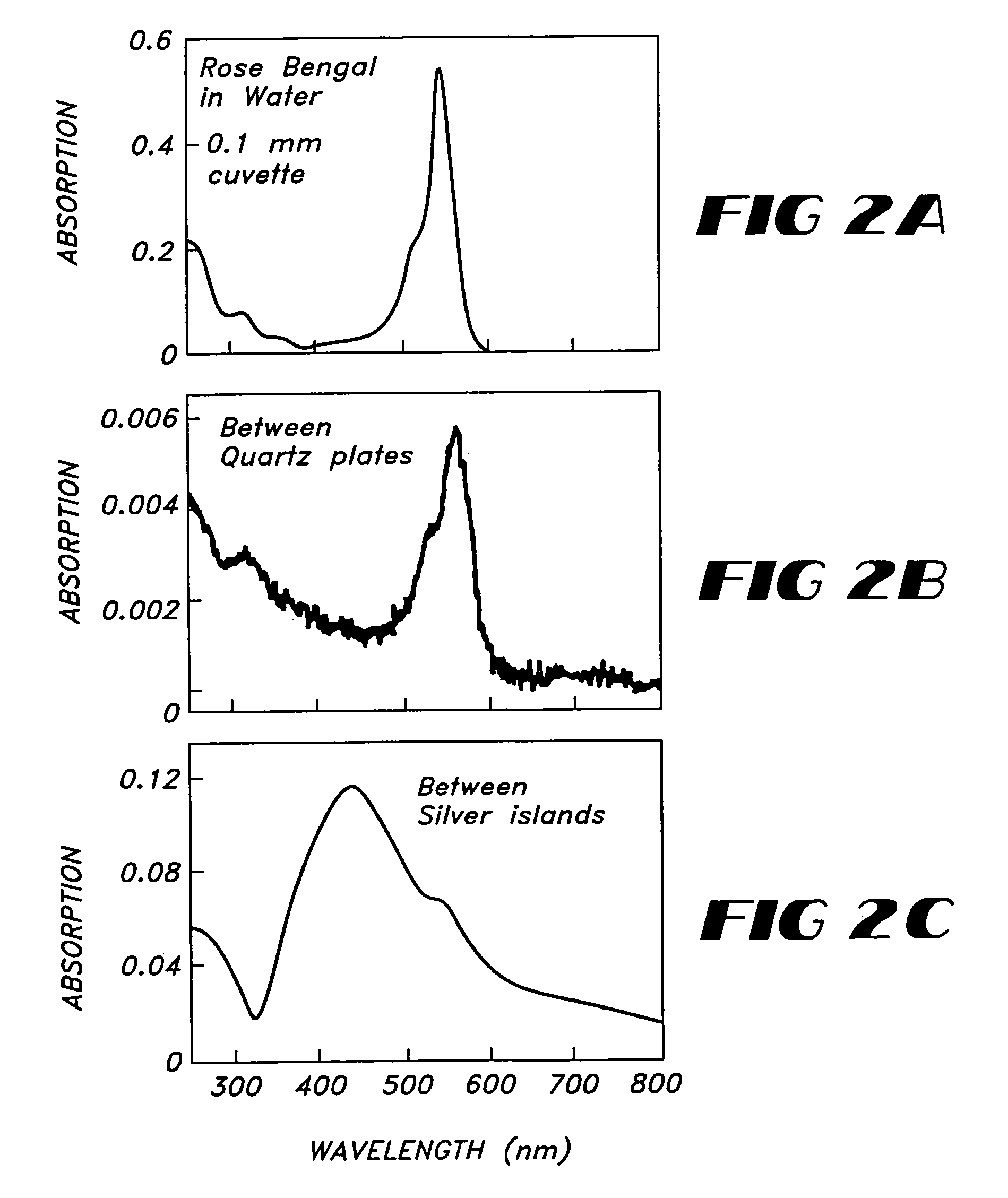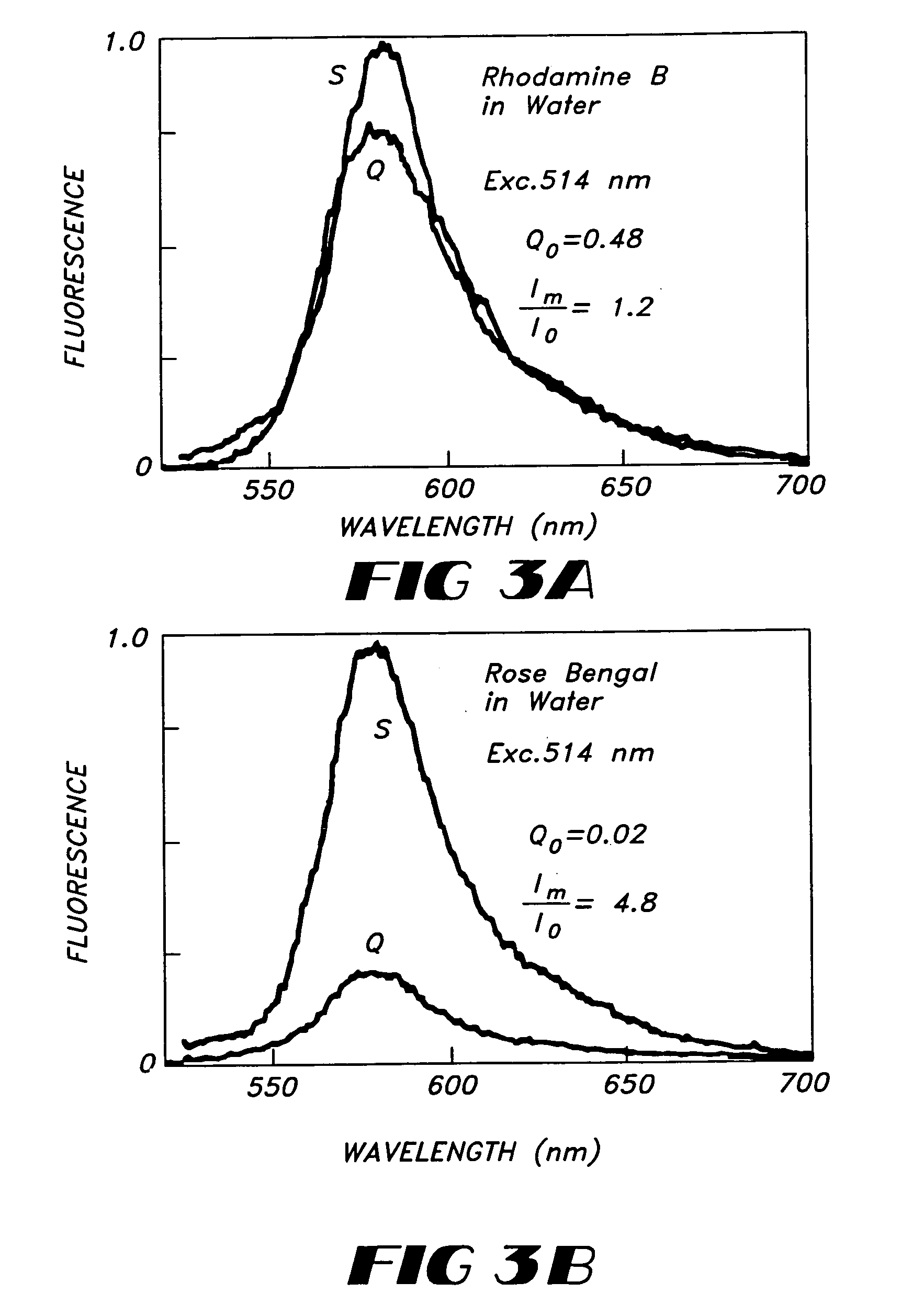Radiative decay engineering
a technology of radioactive decay and fluorescence, which is applied in the direction of chemiluminescene/bioluminescence, biomass after-treatment, peptides, etc., can solve the problems of affecting the biological activity of the biomolecule potentially creating experimental artifacts, limiting the detection of the molecule of interest, and reducing the intrinsic fluorescence of the biomolecule. , to achieve the effect of increasing the intrinsic fluorescence of the biomolecul
- Summary
- Abstract
- Description
- Claims
- Application Information
AI Technical Summary
Benefits of technology
Problems solved by technology
Method used
Image
Examples
example 1
Procedure for Making Metal Nanoparticle Films
[0128] Metal particles or metal particle films are known and can be produced using known methods. The following example uses silver but it will be appreciated that any metal can be used, preferably noble metals. Chemicals used to generate silver particles, silver nitrate (99+%), sodium hydroxide (pellets, 97%), ammonium hydroxide (NH3 content 28-39%), and D-glucose (99.5%) were purchased from commercial suppliers and used without further purification. All procedures were performed using distilled water which was further purified by Millipore filtration. Silver islands were formed on quartz microscope slides. Quartz provided UV transmission and less autofluorescence. The quartz slides used to deposit silver particles were soaked in a 10:1 (v / v) mixture of H2SO4 (95-98%) and H2O2 (30%) overnight before the deposition. They were washed with water and air-dried prior to use.
[0129] Silver deposition was carried out in a clean 30-ml beaker eq...
example 2
Effects of Silver Island Films on Emission Spectra and Lifetimes
[0133] As an initial experiment, the emission spectra of rhodamine B (RhB) and rose bengal (RB) between uncoated quartz plates (O) or silver island films (S) were examined. These two fluorophores were selected because of their similar absorption and emission spectra but different quantum yields of 0.48 and 0.02 for RhB and RB, respectively. In the case of RhB the intensities are similar in the absence and presence of these silver islands (FIG. 3A). There may be a small decrease in the RhB intensity due to the silver islands, which may be due to the quenching effects of metals at short distances.
[0134] Contrasting results were obtained for rose bengal (FIG. 3B). In this case the intensity increased about 5-fold in the presence of silver islands. It is important to recognize that the increased intensity observed for RB represents an underestimation of the quantum yield of RB near the silver islands. This is because only...
example 3
Spectral Shifts in the Presence of Silver Islands
[0142]FIGS. 10A and 10B show the emission spectra of two solvent sensitive fluorophores between quartz plates (O) and silver islands (S). In both cases blue shifts in the emission, which are consistent with a decreased lifetime of fluorophores near the islands were observed. Because fluorophores within 50 Å of the metal are likely to be quenched, it is unlikely that the blue shifts seen in FIG. 10A and FIG. 10B are due to fluorophores bound to the silver islands. Binding of fluorophores to the uncoated quartz surface is also unlikely because uncoated quartz is present for both emission spectra.
PUM
| Property | Measurement | Unit |
|---|---|---|
| wavelengths | aaaaa | aaaaa |
| wavelengths | aaaaa | aaaaa |
| excitation wavelength | aaaaa | aaaaa |
Abstract
Description
Claims
Application Information
 Login to View More
Login to View More - R&D
- Intellectual Property
- Life Sciences
- Materials
- Tech Scout
- Unparalleled Data Quality
- Higher Quality Content
- 60% Fewer Hallucinations
Browse by: Latest US Patents, China's latest patents, Technical Efficacy Thesaurus, Application Domain, Technology Topic, Popular Technical Reports.
© 2025 PatSnap. All rights reserved.Legal|Privacy policy|Modern Slavery Act Transparency Statement|Sitemap|About US| Contact US: help@patsnap.com



